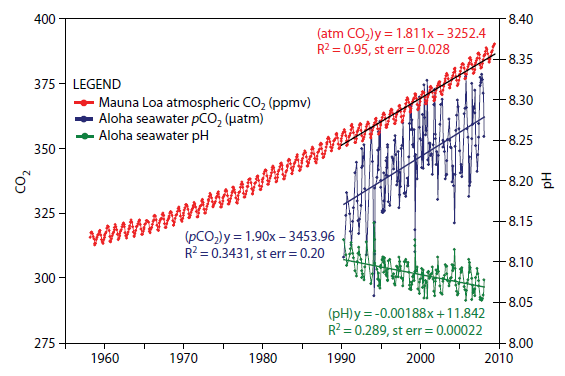Every lab experiment that has been run shows that the critters build thicker shells in response to levels of acid that they would never experience in the oceans. In other words these computer modeled tales are just that...tall tales with no basis in reality.
http://www3.geosc.psu.edu/people/faculty/personalpages/tbralower/Bralower2002.pdf
Evolutionary consequences of the latest Paleocene thermal maximum... ingentaconnect
So you agree it's happening? Let's ignore for the moment the mass extinctions that accompanied the one you reference.
What mass extinctions? A good portion of benthic forams went extinct, but critters higher up in the water columne did fine. Critters go extinct all the time. Further the extinctions were local which leads one to conclude that it was due to anoxic conditions. What is known about the PETM is that terrestrial life exploded. All the mammalian species that exist today, originated during the PETM. You need to get out more...
Here's the wiki entry, crappy as it is, it actually gives a reasoned overview of life during the PETM, and as you can see it was nice.
The PETM is accompanied by a
mass extinction of 35-50% of
benthic foraminifera (especially in deeper waters) over the course of ~1,000 years – the group suffering more than during the dinosaur-slaying
K-T extinction (e.g.,
[27][28][29]). Contrarily, planktonic foraminifera diversified, and
dinoflagellates bloomed. Success was also enjoyed by the
mammals, who radiated extensively around this time.
The deep-sea extinctions are difficult to explain, because many species of benthic foraminifera in the deep-sea are cosmopolitan, and can find refugia against local extinction.
[30] General hypotheses such as a temperature-related reduction in oxygen availability, or increased corrosion due to carbonate undersaturated deep waters, are insufficient as explanations. Acidification may also have played a role in the extinction of the calcifying foraminifera, and the higher temperatures would have increased metabolic rates, thus demanding a higher food supply. Such a higher food supply might not have materialized because warming and increased ocean stratification might have led to declining productivity
[31] and/or increased remineralization of organic matter in the water column, before it reached the benthic foraminifera on the sea floor (
[32]). The only factor global in extent was an increase in temperature. Regional extinctions in the North Atlantic can be attributed to increased deep-sea anoxia, which could be due to the slowdown of overturning ocean currents,
[18] or the release and rapid oxidation of large amounts of methane. Oxygen minimum zones in the oceans may have expanded.
[33]
In shallower waters, it's undeniable that increased CO2 levels result in a decreased oceanic pH, which has a profound negative effect on corals.
[34] Experiments suggest it is also very harmful to calcifying plankton.
[35] However, the strong acids used to simulate the natural increase in acidity which would result from elevated CO2 concentrations may have given misleading results, and the most recent evidence is that
coccolithophores (
E. huxleyi at least) become
more, not less, calcified and abundant in acidic waters.
[36] Interestingly, no change in the distribution of calcareous nanoplankton such as the coccolithophores can be attributed to acidification during the PETM.
[36] Acidification did lead to an abundance of heavily calcified algae
[37] and weakly calcified forams.
[38]
The increase in mammalian abundance is intriguing. There is no evidence of any increased extinction rate among the terrestrial biota. Increased CO2 levels may have promoted dwarfing
[39][40] – which may have encouraged speciation. Many major mammalian orders – including the
Artiodactyla, horses, and primates – appeared and spread around the globe 13,000 to 22,000 years after the initiation of the PETM.
[39
Paleocene Eocene Thermal Maximum - Wikipedia the free encyclopedia



